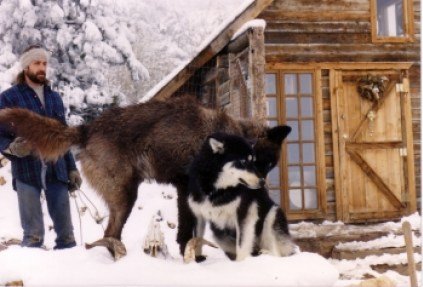History
Mission:Wolf was created out of the need to provide life-long homes for captive wolves and wolf-dogs, as well as to allow humans a chance to understand them. In 1984, our co-founder Kent Weber became licensed to care for a captive wolf in need of shelter. By 1986, Kent and his partner began to take in former pet wolves which the previous owners’ could no longer care for. To give these animals a safe place away from people, he moved to Mission:Wolf’s current location in the remote foothills of the Wet Mountains in Southern Colorado.
Kent was frustrated with the rat race of modern society and understood that humanity needed to be more sustainable. He hoped to build a sustainable house on the land he had purchased, which was south-facing, had its own water source, and was next to public land. However, the more he got involved with rescuing captive wolves, the more he recognized how many thousands of these animals are killed every year. He took in a second and third, until eventually Mission: Wolf had 52 wolves.
Kent with Ambassador wolf Shaman and wolf-dog Hopi
A local science teacher invited Mission:Wolf to bring a wolf into her classroom. After Kent gave a brief presentation, she exclaimed that 20 minutes with a wolf in the room had communicated more to her students than her past 3 months of teaching.
By 1988, the plans to build a residence were discarded, and the land was placed in the wolves’ name. That same year, the entire operation was incorporated as an educational non-profit organization. Mission:Wolf’s ultimate goal is to render facilities like ours obsolete, and see wolves back in the wild instead of behind fences.
Trapped in the middle of nowhere and working frantically to build the facility at 3:00 a.m. in the dead of winter, one of our volunteers declared that the entire thing was “Mission: Impossible.” The name Mission:Wolf was then coined and stuck.
Today, Mission:Wolf has facilitated over 1 million people to greet a wolf. We have run education programs in over 30 states, with groups including National Geographic, Defenders of Wildlife, Mr. Rogers Neighborhood, The Today Show, Harvard, The Cattleman’s Association, and even a Hells Angels chapter.
There are three major components of Mission:Wolf. The first is a sanctuary for wolves and nature center for people. The second is our Ambassador Wolf program, an on-site educational program in which we teach our visitors about the importance of keeping wild animals wild. The third is our land conservation program.
As observed by the first science teacher we visited, the wolves themselves are the most effective teachers. By interacting with a socialized wild animal, visitors are able to learn about the difficult care that these creatures require in captivity. The Ambassador wolves choose whether or not to engage with visitors, which teaches the public about the respect and space these animals need and deserve.
For 27 years, our directors (Kent Weber and Tracy Brooks) traveled the country with the Ambassador wolves to visit schools, universities, museums, and other public facilities. Because of how our organization has grown over the past several years, we have decided to concentrate our efforts on the thousands of on-site visitors that come every year, and the national traveling component of the Ambassador Wolf program has been put on indefinite hold.
